German Bread (Authentic Vollkornbrot)
This post may contain affiliate links. See my disclosure policy.
A thoroughly authentic German Bread Recipe (Vollkornbrot)! This delicious traditional German whole grain seed bread is nutrient dense with a fabulous texture and positively packed with flavor. This makes a large loaf that freezes well so you can conveniently grab some whenever you’re in the mood.
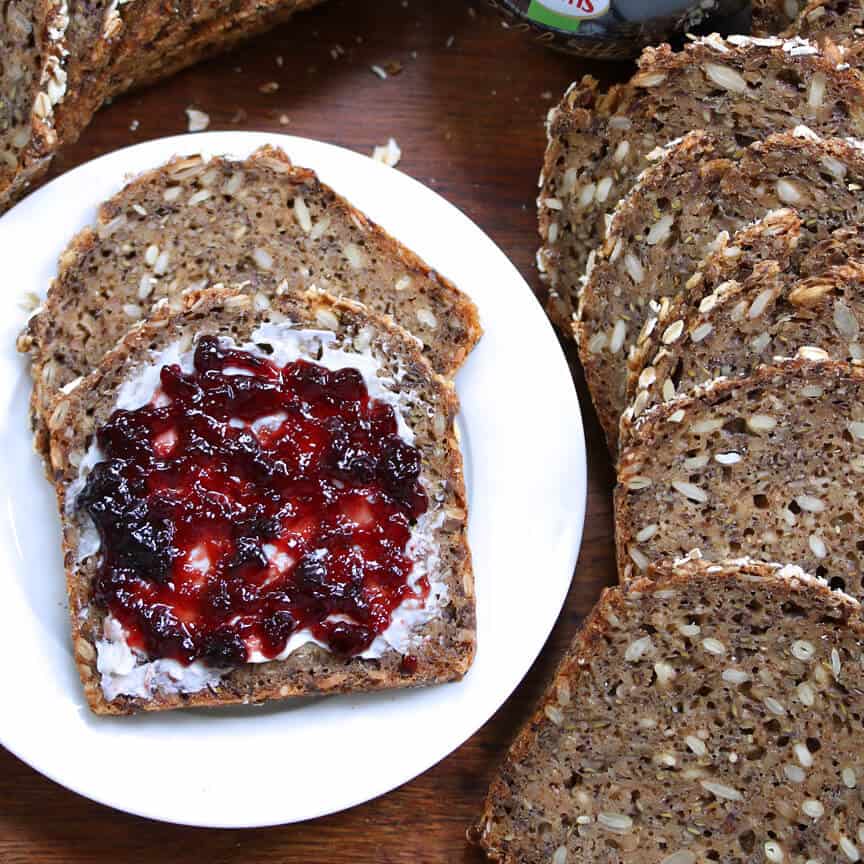
Authentic German Bread (Vollkornbrot)
Few things are better than a freshly baked loaf of bread slathered down with butter and some good jam. That’s true for crusty breads with fluffy interiors and the more hearty, dense breads that I also know and love from Europe. Here is a German bread that is beloved throughout Germany and is also widely enjoyed in Austria and Switzerland. It features a grain called Einkorn that is used throughout much of western Europe, but feel free to substitute other grains according to your preference.
Dense, chewy, packed with nutrition and full of flavor, this whole grain German brown bread (Vollkornbrot) is wonderful with your choice of butter, jam, Nutella, cheese, or cold cuts.
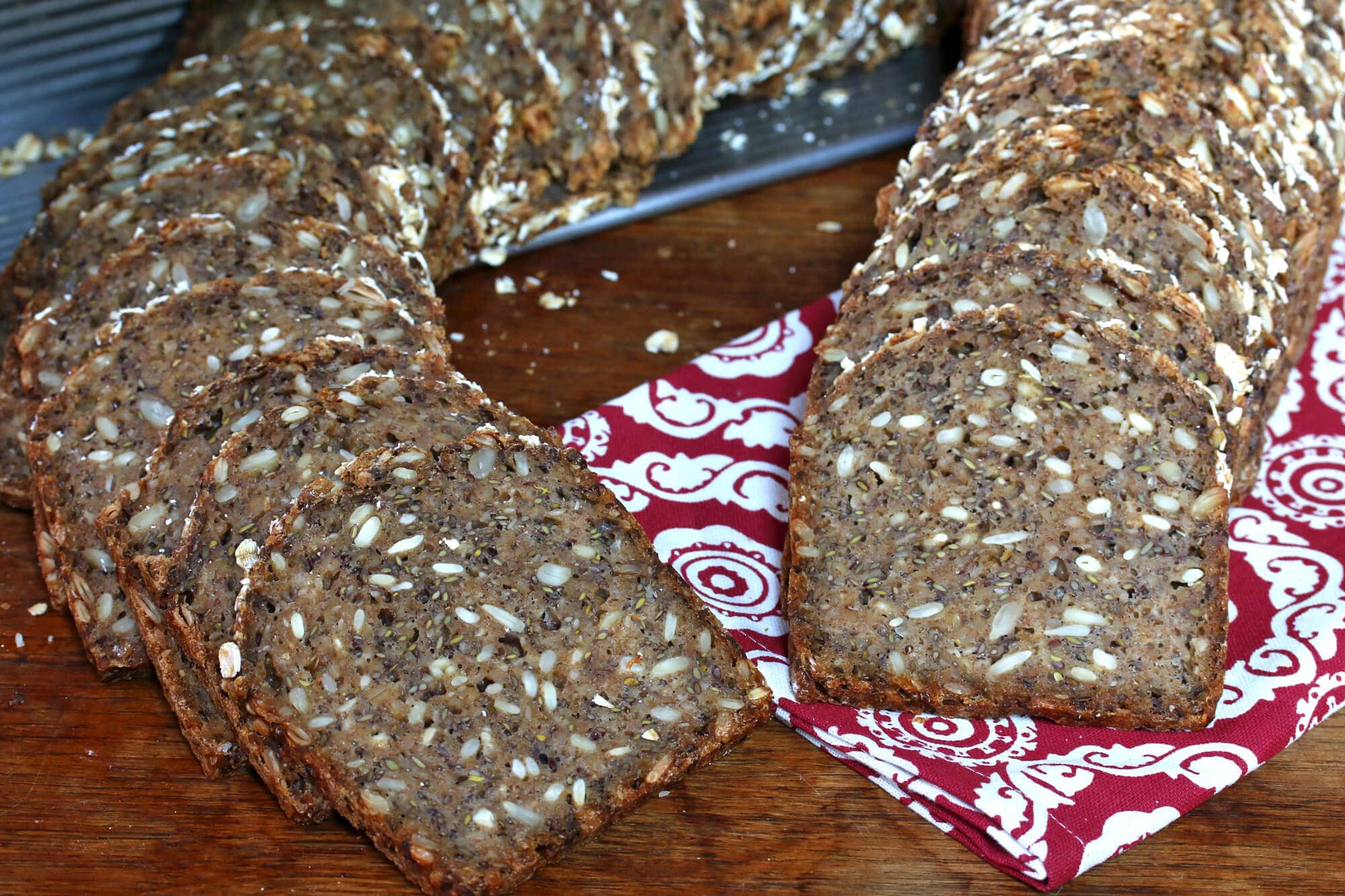
Have you heard of the grain einkorn before? Modern day wheat over the centuries has undergone a series of genetic changes for the purpose of increasing yield and gluten content. It’s almost unidentifiable compared to its ancestor (and my guess is that is why gluten issues are a more recent occurrence). Einkorn is the most ancient form of wheat on earth and hasn’t undergone these genetic changes. It is the purest form of wheat we have. You can purchase einkorn online HERE.
The advantages of einkorn: Most agree it tastes better than wheat and is much easier to digest, even easier than spelt. Compared to the gluten in modern day wheat, it contains a structurally different composition of gluten that the body is able to digest more easily. In fact, some people with gluten issues who have switched to einkorn have found that they’re able to tolerate and digest it with ease.
Even visually there’s a difference between wheat and einkorn. Though there are size variations within different types of wheat, generally most wheat (left) is longer in length than einkorn (right). Einkorn also has a deeper caramel color.
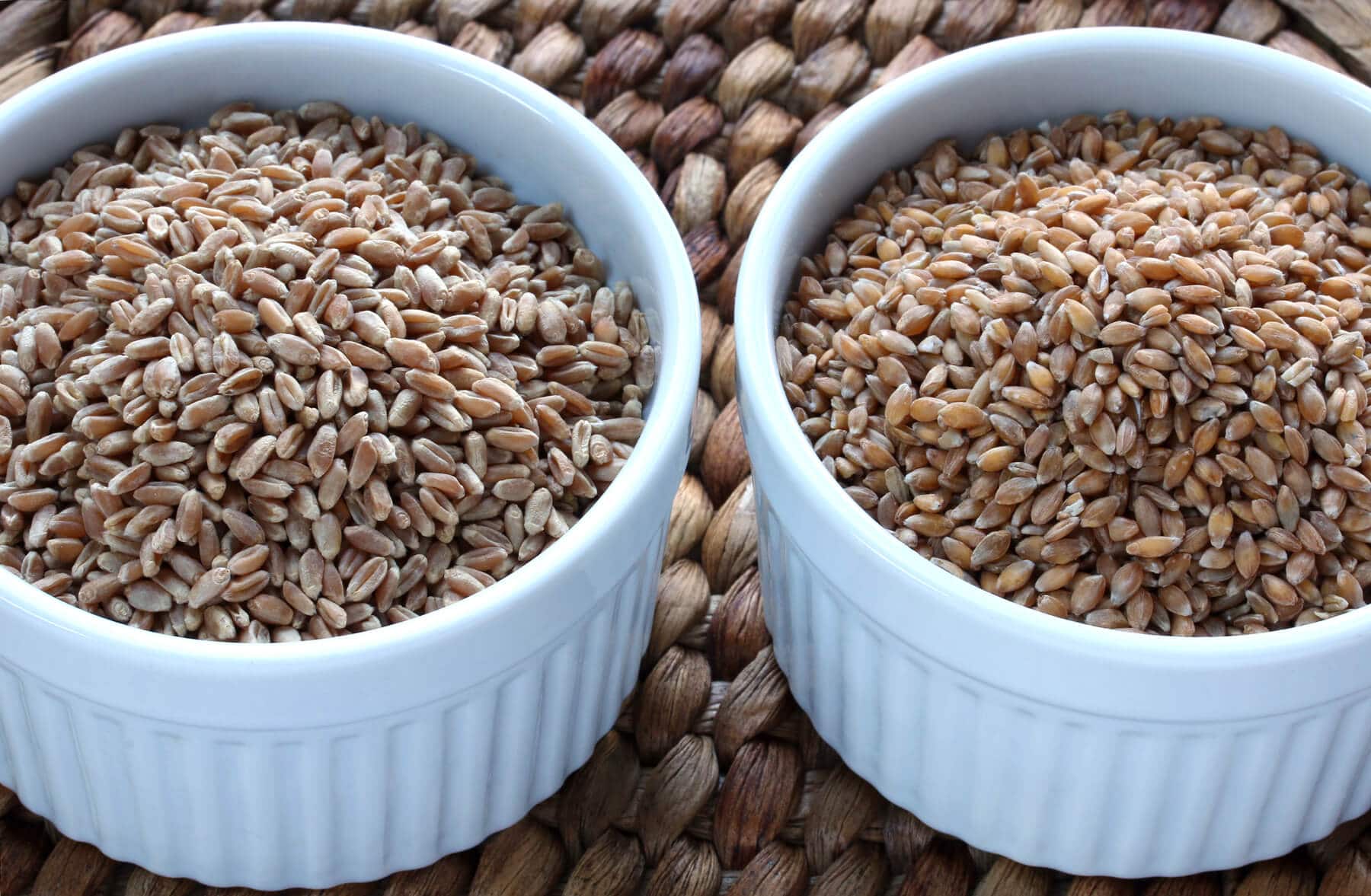
It’s unfortunate that as wonderful as Einkorn is, and common as Einkorn is in many places throughout western Europe, it’s almost unheard of here and very few places sell it. And for that reason it’s also much more expensive here in the U.S.. Hopefully that will change as it becomes more common. The same was true of spelt for a long time and though it’s still far less common than wheat here in the U.S. its price-point has gone down.
I buy all of my grains, including einkorn, in bulk. I take out what I need for a few weeks at a time and store the rest in a dark, cool place. It saves money that way and I have easy access to everything I need. And I LOVE being able to grind my own grains fresh as needed and make up my own fresh baking mixes!
My German-made KoMo grain mill is the pride and joy of my kitchen. German engineering at it’s best, the KoMo grain mill is simply awesome. You can grind your grains as fine or as coarsely as you like. With a 12-year warranty this thing is a work-horse and does a magnificent job. I use it nearly every day grinding my own flours, making cornmeal and a variety of mixes. I cannot recommend it highly enough.
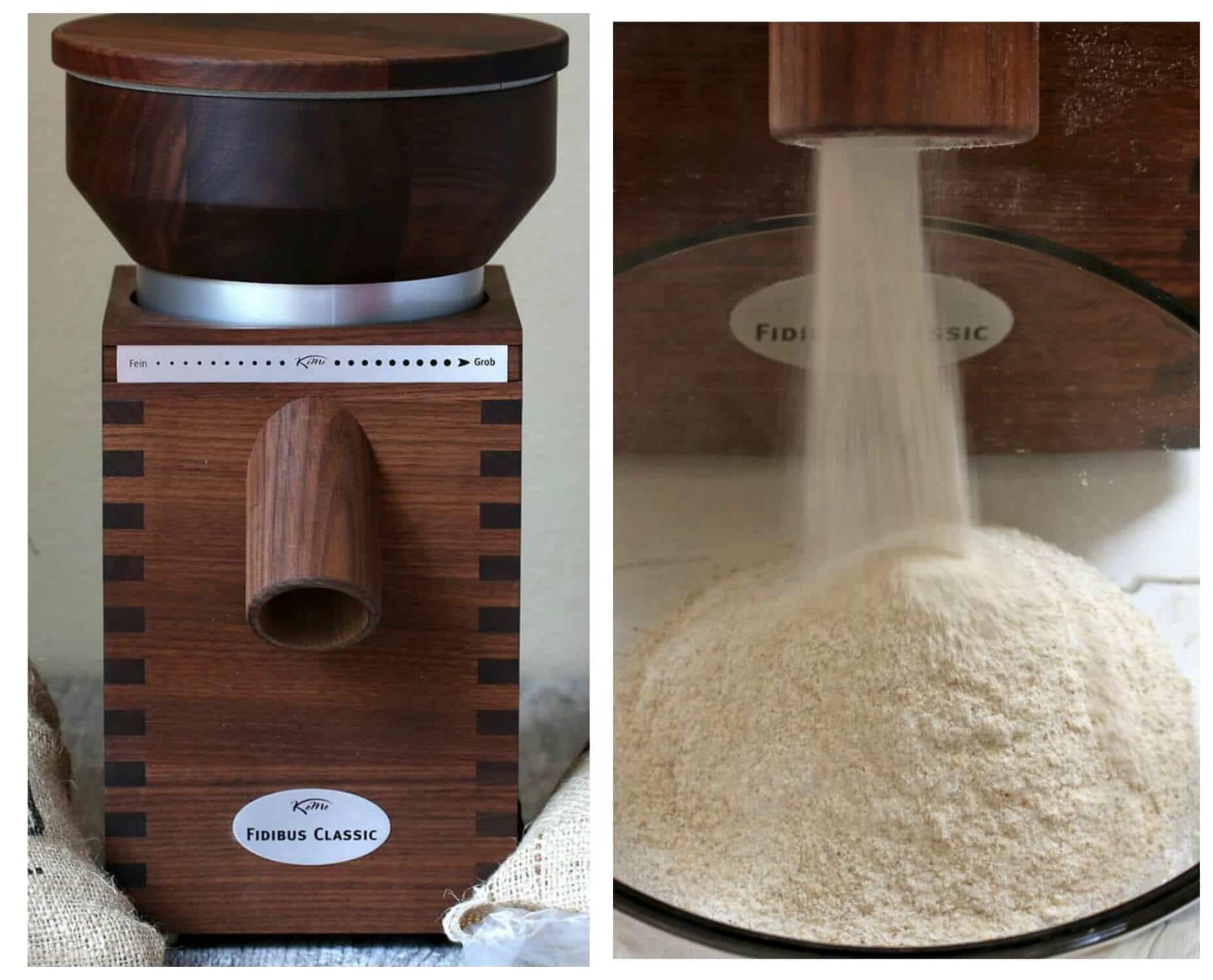
This traditional German bread uses a combination of whole einkorn berries and ground einkorn flour. Whether you’re grinding your own grains or buying the flour already ground, you’re absolutely going to love the texture and flavor of this wonderfully hearty, rustic and thoroughly authentic German bread!
German Sourdough Bread
A couple of our readers have reported back about using sourdough starter instead of yeast. To make this a sourdough Vollkornbrot omit the yeast, add 200 grams of active sourdough starter, and reduce the flour by 100 grams and the water by 100 grams. Give the batter a full 24 hour ferment.
German Bread Recipe (Vollkornbrot)
Let’s get started!
Dissolve the yeast and sugar in the lukewarm water and let sit for 5-10 minutes until frothy. (See above if you prefer to use sourdough starter.)
Place all of the dry ingredients in the bowl of a stand mixer. (You can do this by hand if you prefer.)
NOTE: I personally don’t pre-soak the whole or cracked grain berries and let my batter ferment for a full 24 hours which softens the berries. Depending on the age of the grains you’re using they may require a pre-soaking in order to be adequately soft. If you wish you can pre-soak the grains overnight (pour hot water over them and let them sit) and then thoroughly drain for an hour or so.

Add the yeast mixture along with the buttermilk and beer. Knead on the bread setting (#2) for 10 minutes.
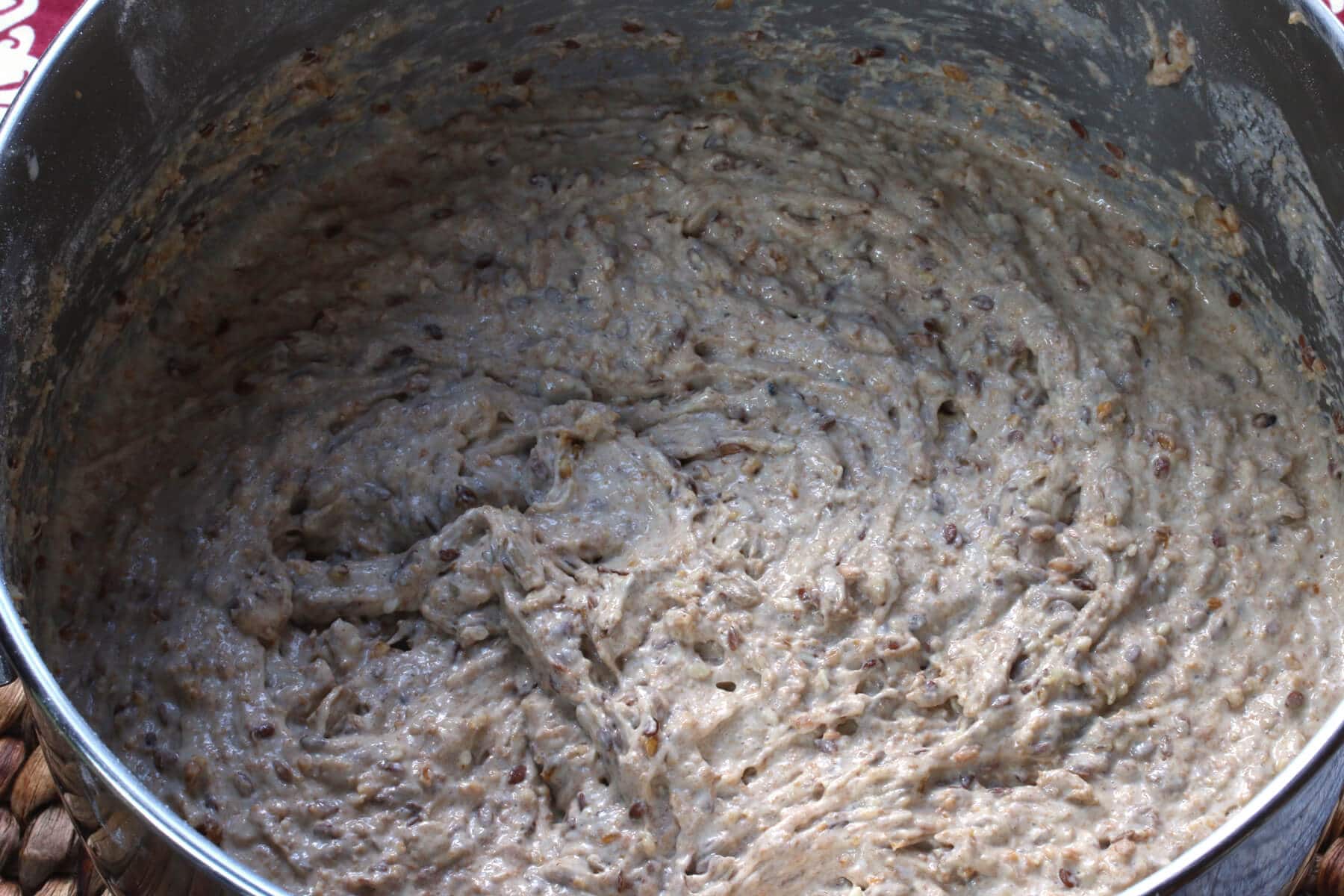
Scoop the mixture into a non-reactive bowl, cover loosely with plastic wrap and let it sit at room temperature for at least 8 hours, preferably longer, up to 24 hours (the longer the better for the whole grain berries to soften and for heightened sourdough properties. If you’re letting it sit for less than 24 hours, presoak the grains overnight in advance and drain thoroughly). Also, the longer it ferments the more liquid will be absorbed so less chances of a moist center after baking.
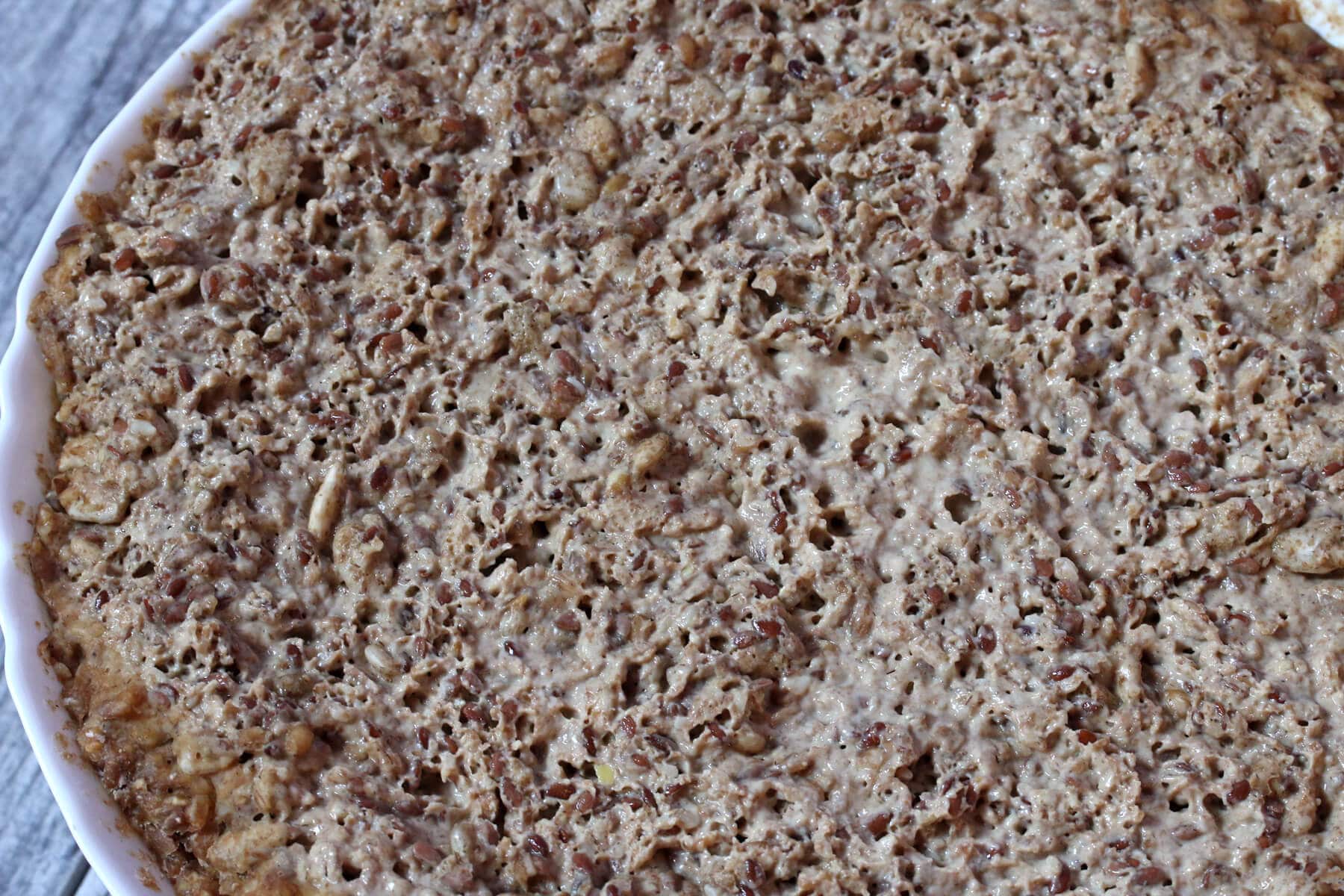
The mixture will be thick and gooey but will not resemble typical bread dough.
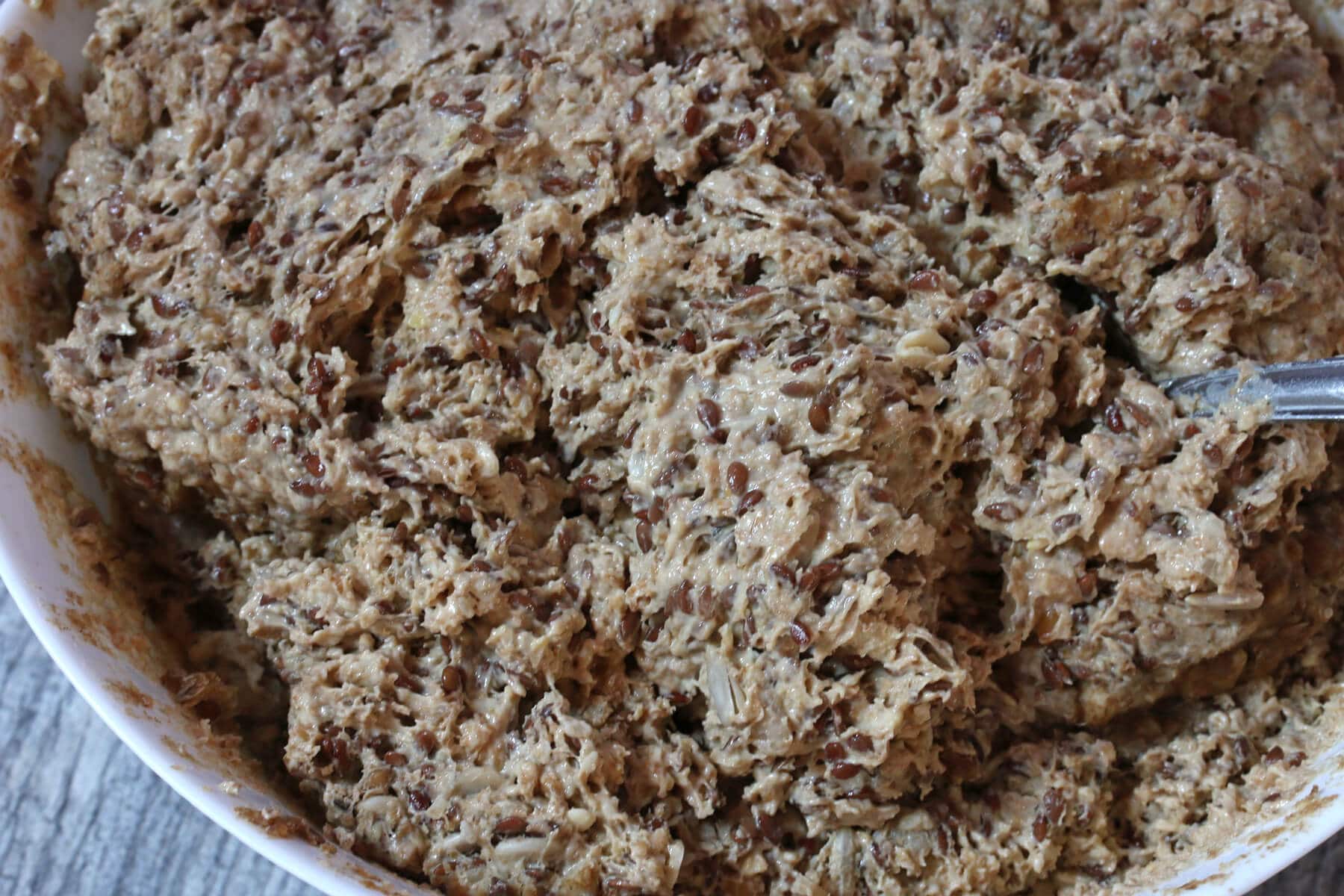
Scoop the mixture into a generously buttered Pullman Loaf Pan and smooth the top so it’s even.
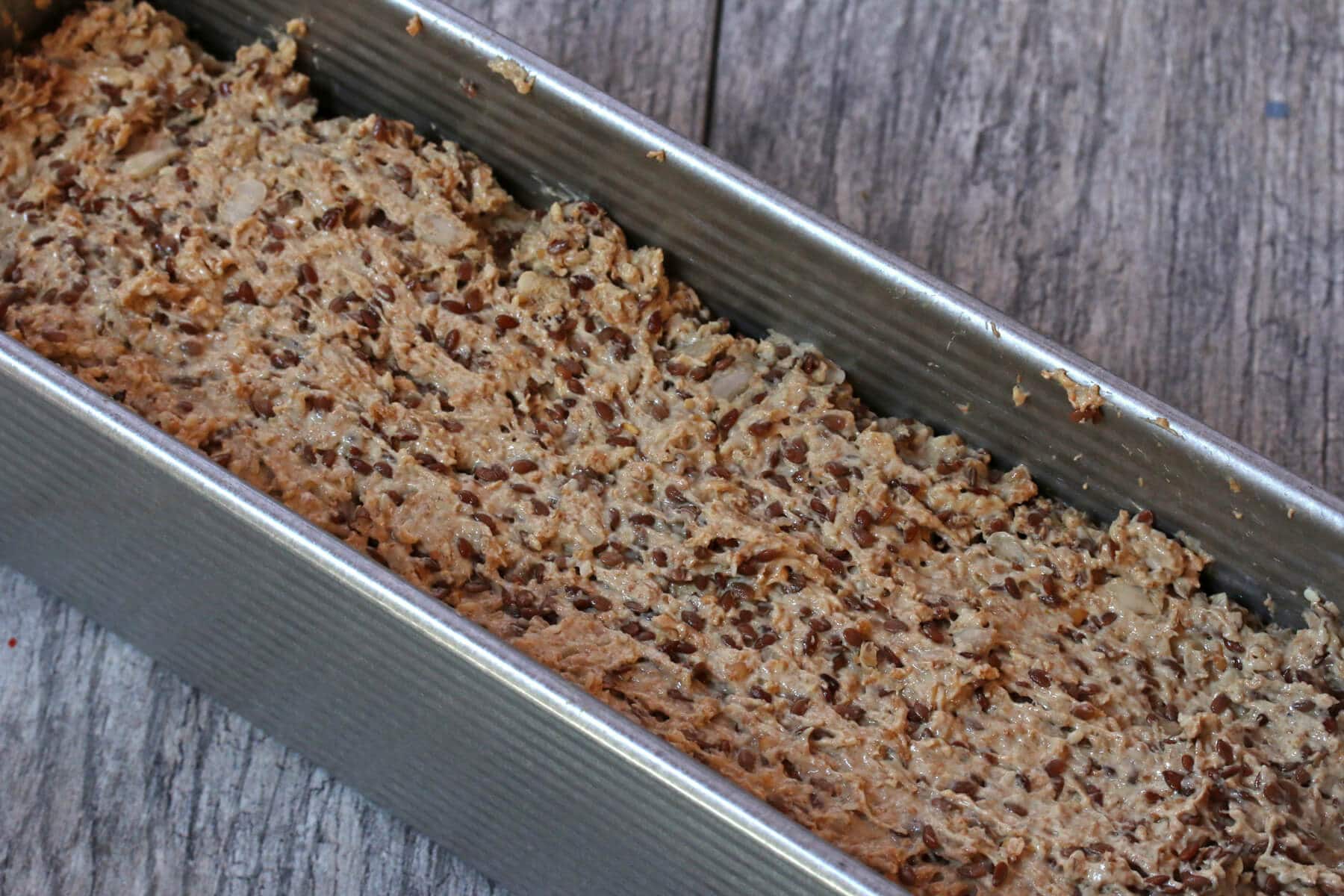
Baking this bread in a Pullman loaf pan yields those nice small, square slices of bread. But it also helps ensure that the center of the bread is fully cooked. Plus, when I’m making other breads that rise a lot, the Pullman has a top on it that slides shut to keep the bread compact (this Einkornbrot doesn’t rise a lot during baking so I don’t bother putting the lid on for it). It’s also the loaf pan that is used to make the famous French pain de mie bread. I like to use it for a lot of my heartier European style breads.
Sprinkle the top with rolled oats.
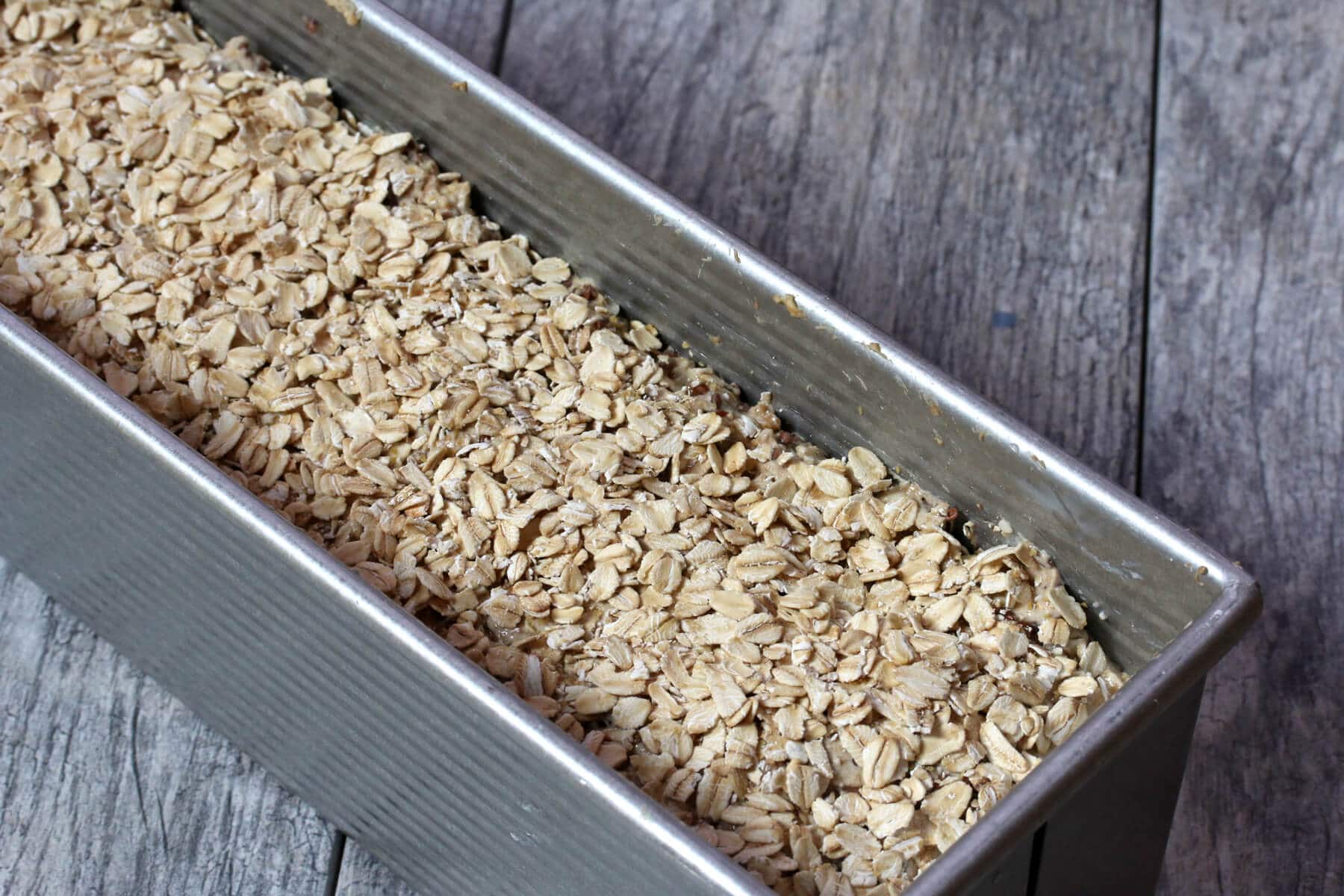
In an oven preheated to 350 degrees F, bake it on the middle rack for 100-120 minutes or until the center is done.
For best and most accurate results, use an instant read thermometer and aim for an internal temperature of 205-210 degrees F.
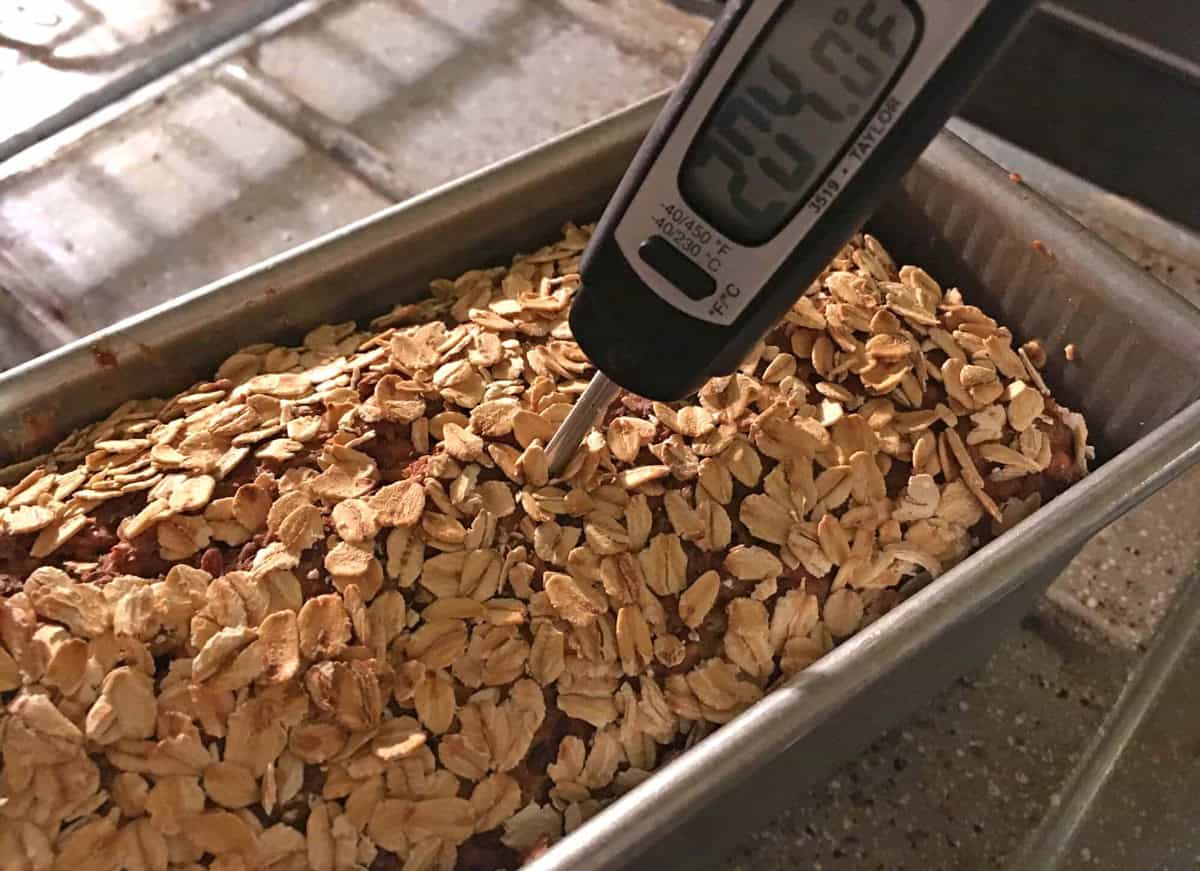
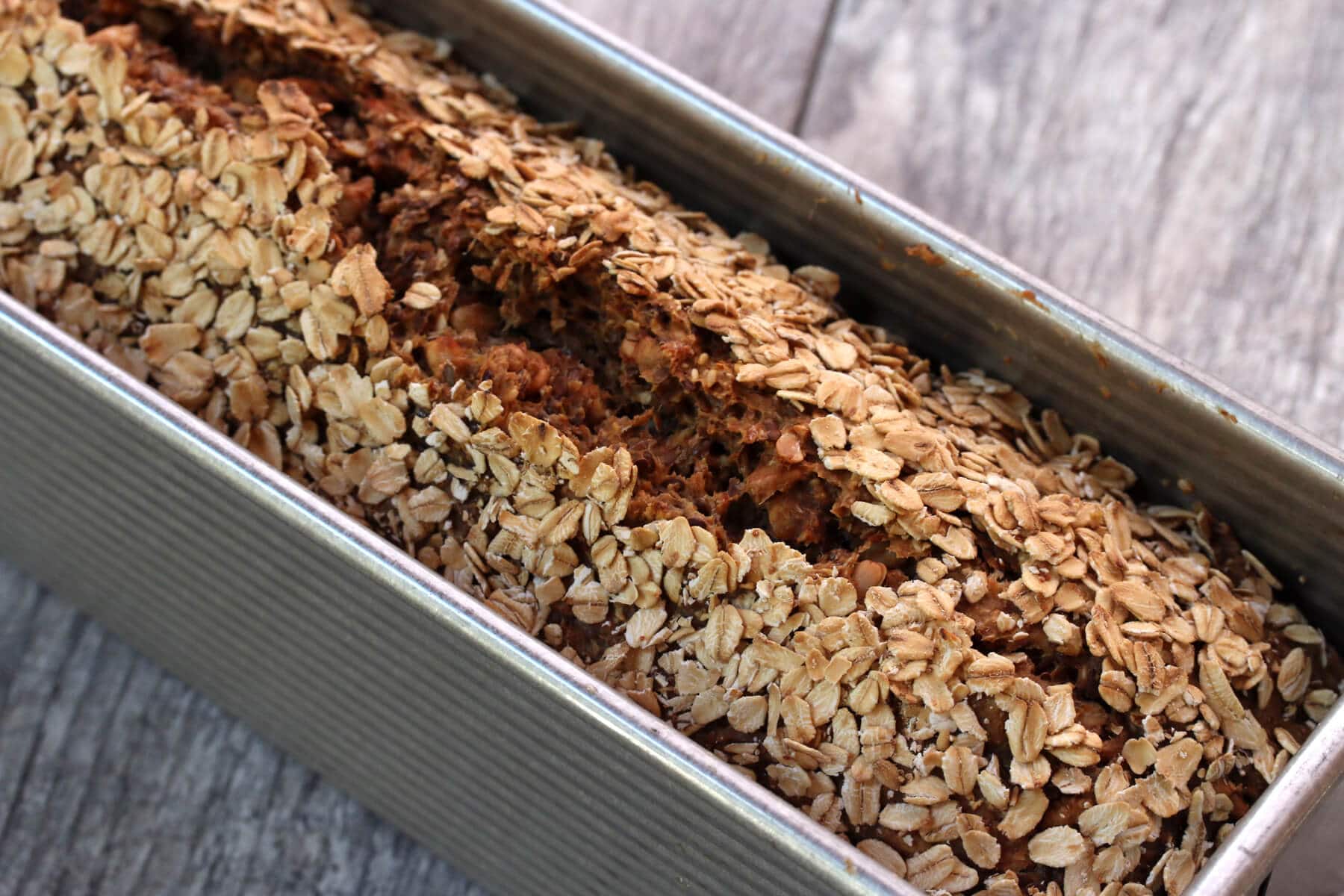
Let is sit in the pan for 5 minutes before removing it, then let it cool completely on a wire rack.
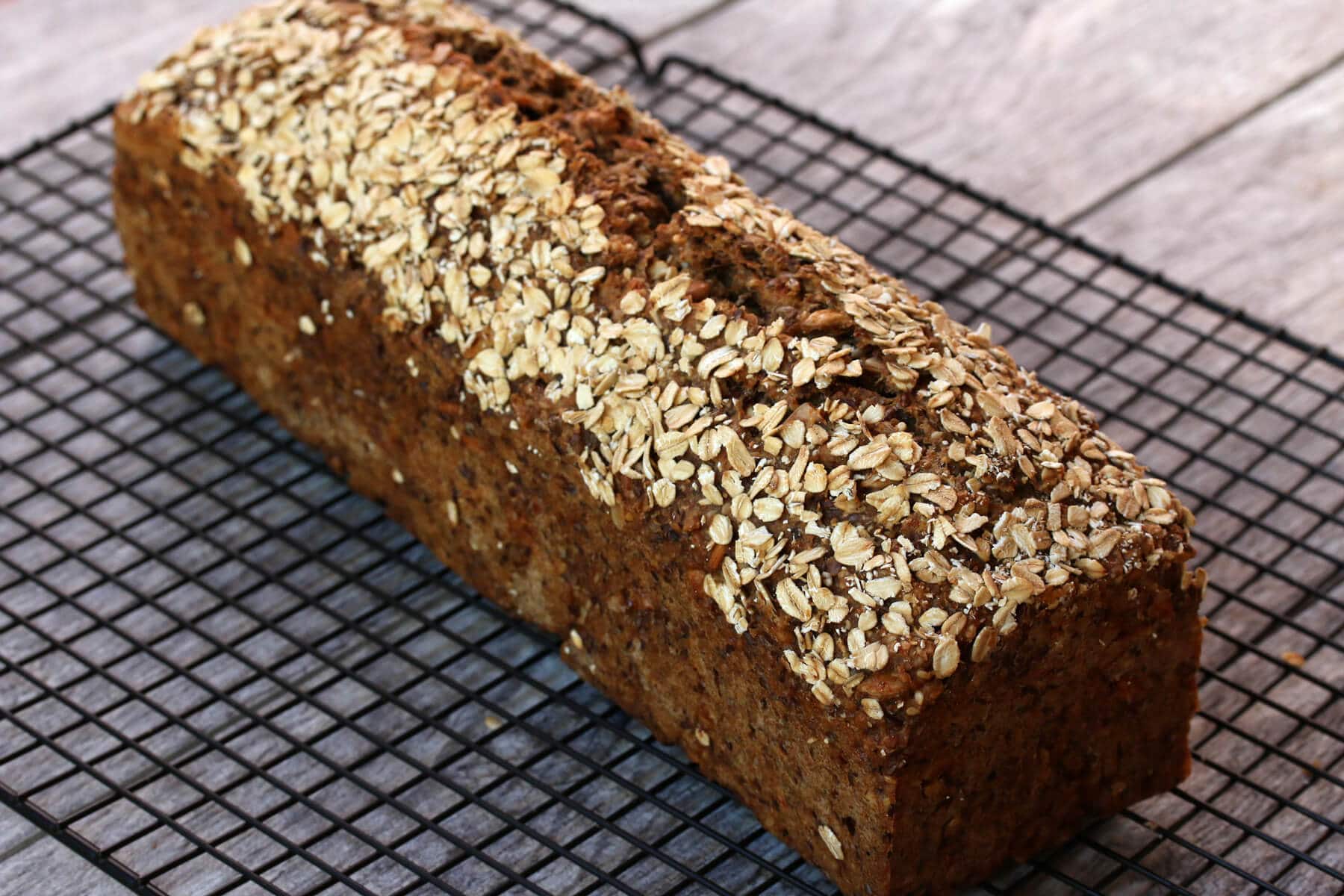
Once cooled you can slice the entire loaf in advance or slice as needed.
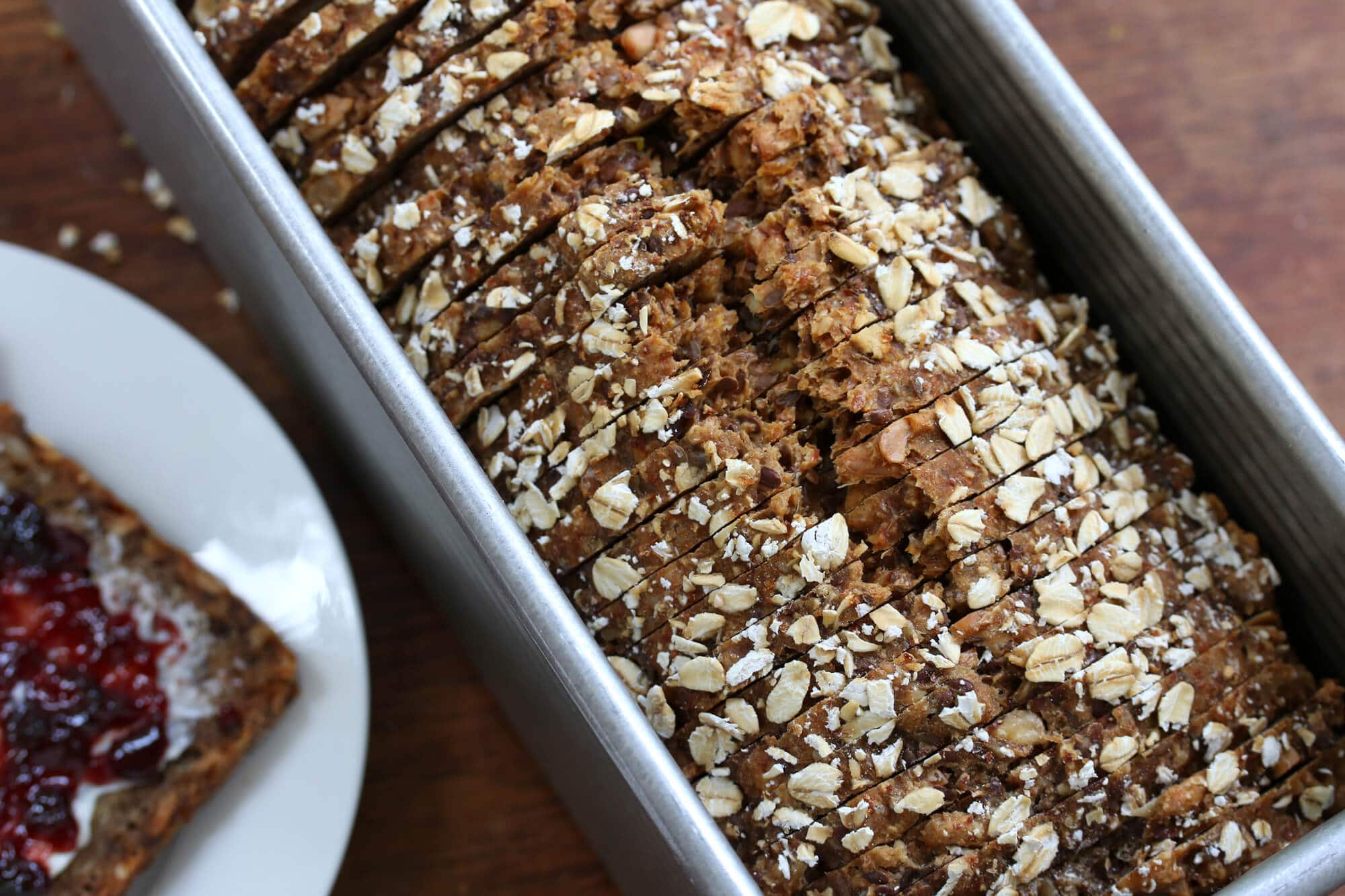
We have a decades-old Hobart commercial slicer that we picked up on Craigslist years ago. I used to be the manager of a delicatessen in England and Hobart is the gold standard in food slicers. In fact, the very same model that we have is on display at the Smithsonian!
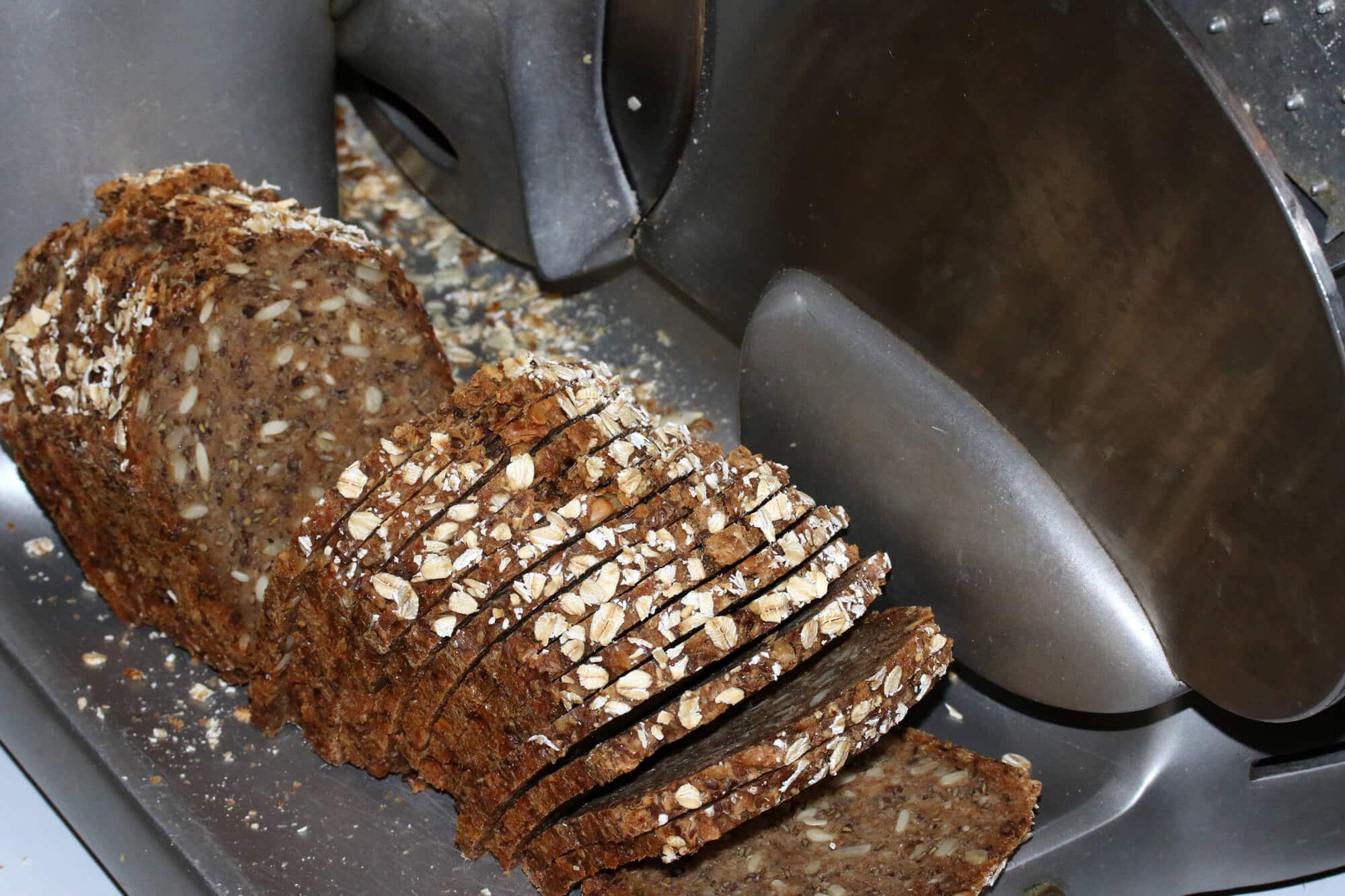
I realize we got lucky and most of you aren’t going to find a good-priced Hobart on Craigslist, but there are other good slicers on the market that are vastly cheaper and do the job. Chef’s Choice Slicers are consistently ranked at the top. I haven’t personally tried one, but they get excellent reviews. Having a good slicer to get clean, thin slices of bread that look like something you bought at a professional bakery is really nice. Plus, whenever I find chunks of cooked ham, turkey or cheese on sale I get those and slice them myself – it’s much cheaper than buying them at the deli.
At the very least you’ll need an excellent bread knife and for that my favorite knife, hands down, is the Cutco 9 3/4″ Slicer. It glides smoothly through bread and meat like no other.
Enjoy!

For more delicious bread from around the world be sure to try my:
- Lavash
- Injera
- Dosa
- Sourdough Naan
- Danish Rye Bread
- Crumpets
- Olive Rosemary Focaccia
- Skillet Cornbread
Save This Recipe
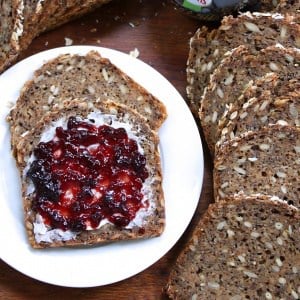
German Bread (Authentic Vollkornbrot)
Ingredients
- 4 1/2 cups einkorn flour (you can also use whole wheat, spelt, rye or combination)
- 1/2 cup whole einkorn berries , or wheat, spelt or rye berries (***See NOTE about soaking)
- 1 3/4 cups cracked einkorn berries , or wheat, spelt, rye (**See NOTE about cracking the grains **See NOTE about soaking)
- 1 cup whole flax seeds
- 1 1/2 cups sunflower seeds
- 1/4 cup sesame seeds
- 3 teaspoons salt
- 2 teaspoons dry active yeast ** see Note for sourdough substitution
- 2 tablespoons sugar , optional but recommended
- 2 cups lukewarm water
- 2 cups buttermilk , at room temperature
- 1 cup mild beer (optional, for a maltier flavor) , at room temperature (can substitute water or buttermilk instead)
- Rolled oats for sprinkling
Instructions
- Dissolve the yeast and sugar in the lukewarm water and let it sit for 5-10 minutes until frothy.
- Combine all of the dry ingredients in the bowl of a stand mixer. (You can do this by hand if you prefer.) Then add the yeast mixture along with the buttermilk and beer. Attach the dough hook and knead on the bread setting (#2) for 10 minutes. Scoop the batter into a large non-reactive bowl, cover loosely with plastic wrap, and let it sit at room temperature for at least 8 hours, preferably longer, up to 24 hours (the longer the better for the whole grain berries to soften and for heightened sourdough properties. Also the longer it ferments the more liquid will be absorbed so less chances of a moist center after baking.)
- Preheat the oven to 350 degrees F.
- Scoop the batter (it will be thick and gooey but not like regular bread dough) into a generously buttered 13x4x4 Pullman loaf pan and smooth the top to even it out. Sprinkle with oats. (Note: Baking this bread in a Pullman loaf pan yields those nice small, square slices of bread. But it also helps ensure that the center of the bread is fully cooked.) I always bake this without the lid on.
- Bake on the middle rack for 100-120 minutes or until the center is done. For best and most accurate results use an instant read thermometer and aim for 210 degrees F. Let the bread sit in the pan for 5 minutes before removing it, then let it cool completely on a wire rack before slicing it. To get clean, professional slices I highly recommend using a bread slicer.
Notes
- How to “crack” the whole berries: I use my grain mill to crack them by putting it on the coarsest setting. Another option is if you have a Vitamix and use the dry container – pulse the whole berries a few times until you get coarse pieces of einkorn. A powerful food processor will likewise do the job. Alternatively you can also place the whole berries in a ziplock bag and use a heavy object to pound them to break them up.
- Soaking the Grains: I personally don’t pre-soak the whole or cracked grain berries and just let my batter ferment for a full 24 hours which softens the berries, and I’ve always had great results. However, depending on the age of the grains you’re using (even if you just bought them they may have sat in the store or warehouse for a long time) they may require a pre-soaking in order to be adequately soft. If you wish you can pre-soak the grains overnight (pour hot water over them and let them sit) and then thoroughly draining.
- **Sourdough Substitution: To make this a sourdough Vollkornbrot omit the yeast, add 200 grams of active sourdough starter, and reduce the flour by 100 grams and the water by 100 grams. Give the batter a full 24 hour ferment.
Nutrition
Originally published on The Daring Gourmet December 11, 2019



















This sounds delicious. Can I make it in my bread machine as well?
Hi Heidi, I have not tried this in a bread machine. Perhaps one of our readers has and can chime in…
We moved to a small town outside Berlin with many bakeries. None make Vollkorn as well as I do with this recipe. My German wife is in heaven. Thank you!
That makes me so happy, Otto, thank you very much for the feedback! :)
Wow! Thank you so much for this recipe and all of your options and feedback. We bought German bread weekly at the only German bakery I knew of in our state, but it closed so I have been making sourdough rye bread for several years. I was looking for a 100% whole grain recipe. Thankfully, I found yours. I gathered all of my flours and grains and reread your recipe and posts from others several times. First loaves are very good. I hadn’t been able to find einkorn flour so I used 1 1/2 c each spelt, rye and whole wheat flours. I used rye chops in place of cracked einkorn and Kamut in place of whole einkorn, flaxmeal instead of flax seed, 1 Tbsp date powder in place of sugar and 1 1/2 tsp salt (we are on low sodium diet), Kefir in place of buttermilk, 3 c room temp water, 2tsp instant yeast, sunflower and sesame seeds per your recipe. I baked it 80 minutes till temp 205 in 2 (4″x8″) loaf pans after rising 19 hours. It is excellent. I can’t wait to try more rye flour, caraway seed and molasses next time. Thank you so much!
Fantastic, Jill, thanks so much for the feedback! I regularly make this with different flours and change up the ingredients, all with great results. This recipe allows for quite a bit of customization and it’s fun to experiment and create different ingredient and flavor combinations.
Great recipe!! Love it!! After the bread has cooled down, but still warm I recommend the loaf be put into ziplock bags and left at room temperature for another 24 hours, this allows the moisture in the bread to soften the crust.
This recipe is AMAZING. It has replaced my typical breakfast of store bought whole wheat toast/cereal and it not only tastes considerably better but I also feel both fuller and less bloated. It’s also very easy and accessible for new bakers.
I used Jovial all purpose einkorn and it turned out very good. I’m baking another load with Jovial whole grain einkorn at this very moment. The batter was a bit soupier than I expected after first mixing, but it became just like the pictures after a full 24 hour proof.
For beer, I used my favorite Pilsner Urquell the first time and am now using Bitburger. For buttermilk, I used the 2 TB vinegar + whole milk trick and it was fine. For the cracked berries I used a food processor for about a minute. And finally for strange people like me who’ve neither bought nor eaten sunflower seeds, buy them hulled, for the love of all that is holy.
Simply the best recipe, thank you so much for sharing your wonderful talents.
That’s fantastic, Cameron, I’m so happy you enjoyed this bread and that it’s becoming a regular in your home – thank you!
Love, love, love this recipe and have made it many, many times in my Pullman pan often varying the seeds and my family loves it. One question though, my loaves can get holes/tunnels in it, sometimes quite large, and I haven’t been able to figure out why. Any ideas?
Thank you, Kim, I’m so glad it’s become a regular! I’ve gotten holes/tunnels on a couple of occasions as well. It’s caused by excess gas from the yeast and that can happen for a variety of reasons, but two of the big ones are over-proofing the batter (the recommended length of time is a general gauge and will vary depending on how warm your “room temperature” is – the warmer it is the faster the batter will proof/ferment), and another common reason is that the oven isn’t hot enough when you put the loaf in (continue to allow the oven to preheat for a good 15-20 minutes AFTER it says it has reached the correct temperature).
Hello,
I ordered all ingredients and can’t wait to bake this bread. I accidentally ordered All-purpose Einkorn flour, that shouldn’t be a problem, right?
I was also wondering, if I could substitute the sugar with German Suger beet syrup? I still got some left from Christmas baking. How much should I use?
Thank you for the great recipe. Can’t wait to slather a slice with butter and Kalbsleberwurst 🙂
Hi Daniel! Yes, the flour is fine. You can use 2 tablespoons of the syrup and just reduce the water or buttermilk by 2 tablespoons. Happy baking and please let us know how it goes!
This is awesome, I love it. Was so good with veal liverwurst and a glass of cold milk. Bringing back childhood memories 🙂.
Wasn’t happy with the beer I used, will try a different one (Bavarian Wheat Beer or German Malta) next time.
Will experiment with different ingredients: Whey substituting some or all of the water, rye flour, pumpkin seeds.
Thank you for the recipe.
That’s wonderful, Daniel, I’m happy to hear it! Thanks so much for getting back to us on how it went and have fun experimenting!
Thank you for the recipe. I made so many batches, they turned out lovely. My husband is German and the whole family love this bread.
Any possible substitute for buttermilk? We are trying to consume less animal products but still would love to eat this bread.
Thanks.
Thank you so much, Pud, I’m thrilled that it’s become a family favorite! You can use a non-dairy alternative instead (e.g., almond milk, rice milk, etc), stir about 1 1/2 tablespoons of white vinegar in it, let it sit for 5-10 minutes and then use that in place of the buttermilk.
How much should I expect it to rise in 24 hours? Thanks – really looking forward to this!!
Hi Mary, not a ton, definitely not doubled in size. It will rise some but mostly it will become bubbly. After 24 hours at room temp it will be ready to bake. Happy baking! :)
What was the length of your Pullman pan used?
13 x4x4?
Hi Daniel, yes, that is the size of mine.
Turned out perfect! I used 100% whole grain dark rye flour, subbed steel-cut oats for the whole einkorn berries because I didn’t have any and bulgur wheat for the cracked einkorn berries (again, because that’s what I had on hand). I used all other ingredients as stated in the recipe. I didn’t pre-soak the grains and let the mixture sit in an oven with the light on for the full 24 hours. Even after baking for 2hrs and 10 minutes the internal temp was 195 degrees F so I decided it was done. Since whole rye sucks up moisture like nobody’s business I believe this helped to have an interior that was moist but not soggy.
I let it rest overnight wrapped in a kitchen towel and the next day it sliced perfectly and tasted delicious! Can’t wait to make it again. Nom, nom, nom!
Thank you, Teresa, I’m so happy you enjoyed it and appreciate the feedback!
Hi! I have no mixer and wondering if I can also make this bread as ‘no knead’ So I combine all the wet and dry ingredients, mix them with a spoon and let it rise for at least 24 hours, so the gluten can form themself? The same question for the Danish ryebread,
Hi Sanne, I haven’t tried this as a “no knead” bread so I can’t speak to the results. I would just recommend stirring it “really” well in the absence of a mixer.
Hi Kimberly! First of all, I want to say thank you for all your work! My family thoroughly enjoying all the dishes I have cooked under your direction. My Scottish husband looks forward to Dundee cake for his birthday now, he pretty much just savors it for a week and does not share. I made it 3 times so far. LOL I will be baking Vollkornbrot finally this weekend and I have plain kefir in a fridge. Is that ok to use it instead of buttermilk? It is a bit thicker than buttermilk, but it seems like should be a decent substitute. I will be using beer too. What are your thoughts? Thank you so much!
Thank you so much, Natalya, I really appreciate your kind words and am thrilled that you’ve made and enjoyed several of my recipes! <3 Yes, you can use kefir instead. Happy baking!
This bread is AMAZING! My husband is from Germany and we go there all the time, naturally when we come back, we miss the delicious bread…I usually make for us a “dinkelbrot” that is super simple to make and similar to what we have over there but yesterday I took a stab at this one and this is just like from a bakery in Germany!
Thank you for all your amazing recipes, I also make your Lebkuchen in christmas and same review as this bread, simply delicious.
Do you happen to have a recipe for Leberkase? ;)
Thank you so much, Ingrid, that makes me very happy to hear! :) I have experimented with making homemade Leberkäse and finally have the flavor down perfectly but not the texture – that’s still going to take some experimenting.
Looks fantastic! Is there a buttermilk substitute for vegans?
Hi Hope, yes you can substitute 2 cups of plant-based milk like almond or rice milk. Stir 2 tablespoons of lemon juice or white vinegar into the milk and let it sit for 5-10 minutes before using.